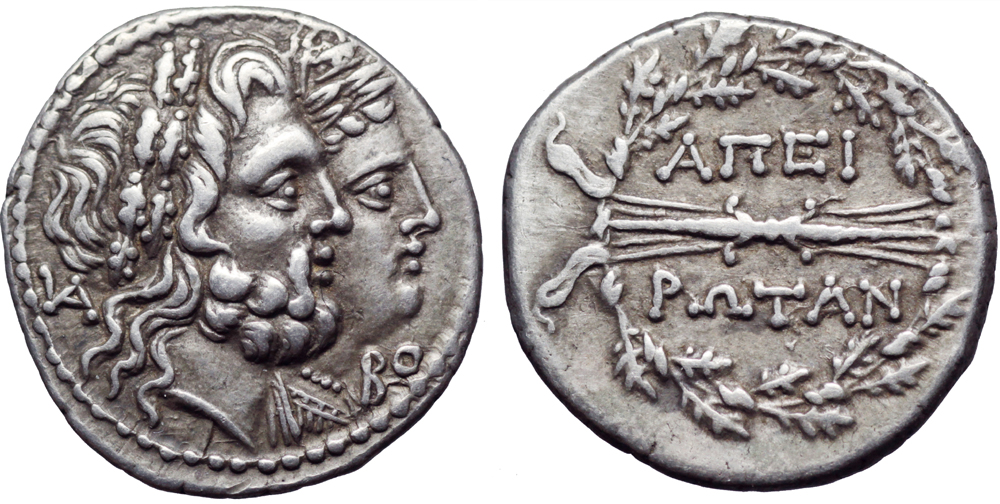H 139 - Epirus (uncertain mint) (Epirote League), silver, tritai (234-168 BCE)
From SILVER
234 BCE - 168 BCE Silver 2,093 kg
Description
| ObverseInscription or printing placed on the obverse.: | Jugate heads right of Zeus Dodonaeus, wearing a wreath of oak leaves, and Dione, diademed and draped. |
| ReverseInscription or printing placed on the reverse.: | AΠEIPΩTAN (Greek).Monogram behind, BO before / Thunderbolt, ΑΠΕΙ above, ΡΩΤΑΝ below, all within oak wreath. |
Mint and issuing power
| MintIdentifies the place of manufacture or issue of a numismatic object.: | Epirus (uncertain mint) | Ancient regionAncient region.: | Epirus | Modern countryModern country: Greece | AuthorityIdentifies the issuing power. The authority can be "pretended" when the name or the portrait of X is on the coin but he/she was not the issuing power. It can also be "uncertain" when there is no mention of X on the coin but he/she was the issuing power according to the historical sources: | Epirote League |
Chronology
| FromIdentifies the initial date in a range assigned in a numismatic context. | 234 BCE | toIdentifies the final date in a range assigned in a numismatic context.. | 168 BCE | PeriodTime period of the numismatic object.: Hellenistic 323-30 BC |
Physical description
| MetalThe physical material (usually metal) from which an object is made.: | Silver |
Median weightMedian of the weights of numismatic objects (in grams). in grams | 3.20 | DenominationTerm indicating the value of a numismatic object. Examples: tetradrachm, chalkous, denarius.: | trite |
StandardStandard.: |
Image

H139 Zeus Dodona thunderbolt.jpeg [1]
References
| Die study referencePublication of the study: | Franke 19611Franke 1961 | ||
| Coin series referenceReference to coin series study: | Sear I2Sear I, n° 1997, RQEMH3RQEMH, n° 139 | ||
Obverse dies distribution
| FrequencyFrequency of specimen in distribution. ᵖ | Number of obversesNumber of obverse dies. ᵖ (o) | % (o) | Number of coinsNumber of coins. (n) | % (n) | Die nameName(s) of the die(s). |
| 1 | 10 | 38.46 | 10 | 12.5 | 171, 172, 175, 177, 180, 184, 187, 189, 191, 192 |
| 2 | 5 | 19.23 | 10 | 12.5 | 167, 179, 182, 188, 190 |
| 3 | 5 | 19.23 | 15 | 18.75 | 173, 178, 181, 183, 185 |
| 5 | 1 | 3.85 | 5 | 6.25 | 176 |
| 6 | 3 | 11.54 | 18 | 22.5 | 170, 174, 186 |
| 9 | 1 | 3.85 | 9 | 11.25 | 169 |
| 13 | 1 | 3.85 | 13 | 16.25 | 168 |
| Total | 26 of 26 | 100.01 | 80 of 80 | 100 |
Reverse dies distribution
no distribution is available
Quantification
| Number of obversesNumber of obverse dies. ᵖ (o) | 26 | Number of singletons (o1)The number of singleton coins. ᵖ | 10 |
| Number of reverse diesNumber of reverse dies. (r) | 21 | Number of coinsNumber of coins. (n) | 80 |
| Coins per obverse dieNumber of coins per obverse die. (n/o) | 3.08 | Coins per reverse dieNumber of coins per reverse die. (n/r) | 3.81 |
| Reverse per obverse ratioRatio of obverse dies divided by reverse dies. (r/o) | 0.81 | Percentage of singletons (o1)number of coins (n) divided by the number of singletons (o1) ᵖ | 38.46 % |
| Original number of dies (O) (Carter 1983 formula)The estimation of the number of coins according to Carter 1983 ᵖ | 32.7 | Coins struck if 20,000 as average productivity per dieCoins made if the average productivity for obverses (according to Carter) is 20,000. ᵖ | 654,000 |
| Original number of dies (O) (Esty 2011 formula)The estimation of the number of coins according to the singleton formula in Esty 2011 ᵖ (O) | 38.52 | Survival rate if 20,000 as average productivity per dieSurvival rate if average productivity is 20,000. ᵖ | 0.00012 |
| Coverage (o = % of O) (Esty 1984 formula)Esty 1984 - coverage (% of O) ᵖ (o = % of O) | 87.5% | Die productivity if survival rate 1/2,000Average productivity if survival rate is 1/2,000. ᵖ | 4,892.97 |
| Weight of silver (in kg) if 20,000 coins per die (O = Carter formula)Carter 1983 * Median weight * 20000 (*10 if gold or electrum) ᵖ | 2,093 kg <br /> 2,093 kg | Die productivity if survival rate 1/5,000Average productivity if survival rate is 1/5,000. ᵖ | 12,232.42 |
Remarks